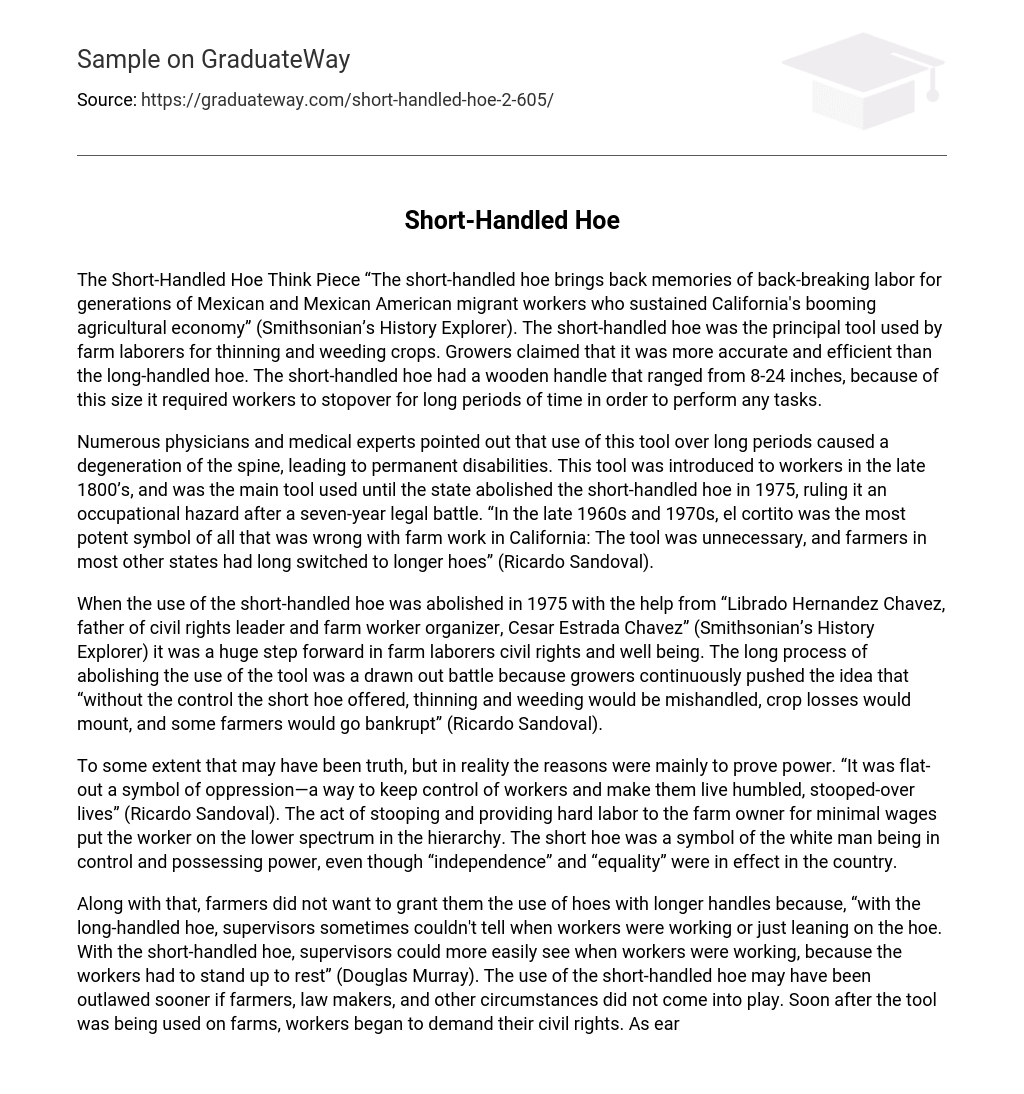“The Short-Handled Hoe Think Piece” focuses on the significance of the short-handled hoe in the memories of Mexican and Mexican American migrant workers who contributed to California’s thriving agricultural industry, as highlighted by Smithsonian’s History Explorer. This tool, used primarily for thinning and weeding crops, was believed by growers to be more precise and effective compared to the long-handled hoe. With a wooden handle spanning between 8 and 24 inches in length, the short-handled hoe necessitated extended breaks for workers to accomplish their tasks.
According to physicians and medical experts, the prolonged use of this tool led to a decline in spine health, causing permanent disabilities. The tool was first given to workers in the late 1800s and continued as their main equipment until it was recognized as an occupational danger. After a seven-year legal fight, the state finally banned its use in 1975. Ricardo Sandoval commented on this issue saying, “During the late 1960s and 1970s, el cortito represented all the challenges connected with agriculture labor in California: it was unnecessary compared to longer hoes used in other states.”
When the use of the short-handled hoe was eliminated in 1975, it marked a significant advancement in the civil rights and welfare of farm laborers. This achievement was made possible with the assistance of “Librado Hernandez Chavez, father of civil rights leader and farm worker organizer, Cesar Estrada Chavez” (Smithsonian’s History Explorer). However, the process of eradicating the use of this tool was a prolonged struggle due to constant opposition from growers. They argued that without the control provided by the short hoe, thinning and weeding tasks would be mishandled, leading to crop losses and potential bankruptcy for farmers (Ricardo Sandoval).
The reasons behind using the short hoe may have had some element of truth, but ultimately its purpose was primarily to demonstrate power. As Ricardo Sandoval explains, it was a clear symbol of oppression, serving as a means to maintain control over workers and force them into a life of humility and backbreaking labor for meager pay. This dynamic placed the worker at the bottom of the social hierarchy. Despite claims of “independence” and “equality” in the country, the short hoe represented the white man’s dominance and authority.
Farmers were resistant to granting workers longer-handled hoes because it made it difficult for supervisors to distinguish between actual work and leaning on the tool. However, with the use of short-handled hoes, supervisors could easily observe when workers were working or resting. According to Douglas Murray, protests and work stoppages by farm workers against the use of short-handled hoes date back as early as the 1920s. These efforts would have succeeded if it weren’t for the influx of impoverished individuals from Oklahoma, Arkansas, and other regions who were willing to accept low wages and perform any type of work, including using the short-handled hoe. Thus, during times of economic hardship, both farmers and desperate individuals hindered the movement to abolish this grueling tool on Californian farms.
After 75 years and numerous cases, the era of the short-handled hoe finally ended. In 1972, the first official complaint was filed with the state’s Division of Industrial Safety. Sebastian Carmona, a 46-year-old farm worker from Texas who arrived in 1959, led this legal battle. Despite initial rejection by the DIS, the state Supreme Court later overturned this decision and acknowledged how using the short-handled hoe negatively affected workers’ health due to constant stooping.
Despite the Supreme Court overturning the ruling, state regulators remained unmoved and did not prohibit the use of a long-handled hoe by 1975. This lack of action led to frustration, prompting Jourdane to reach out to the UFW. The UFW then contacted the new governor, Jerry Brown, who exerted executive pressure that finally compelled bureaucrats to exclude the ‘el cortito’ from use in fields.
The prohibition of the short-handled hoe has led to better conditions for farm workers and a decrease in claims for back injuries by growers. Additionally, the positive outcome of this case, combined with the strong organization developed to advocate for farm workers, has encouraged protests addressing other issues, such as exposure to hazardous pesticides. Overall, the protest regarding a single tool, with support from government and legal entities, has given rise to the ongoing farm workers movement (Douglas Murray).
The discontinuation of the short-handed hoe as the main agricultural tool not only protected future workers’ health but also symbolized a significant step towards equality. Smithsonian’s History Explorer states that during a time of political mobilization, the difficulties endured by migrant farm workers reflected the limited opportunities and deep poverty experienced by many Mexican Americans. Advocates for labor rights considered it an essential aspect of the wider civil rights movement.
Both Mexican Americans and other low-paid workers found the abolishment of the short-handed hoe to be significant. Works cited in this regard are Murray, Douglas. Architects of Change: Reconstructing Society. “The Abolition of the Short-Handed Hoe”. 2004.





